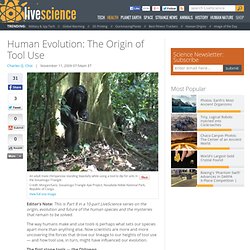

Human Evolution: Where We Came From. Editor's Note:This is Part 4 in 10-part series LiveScience series on the origin, evolution and future of the human species and the mysteries that remain to be solved. The dawn of humanity remains a fascinating mystery. What started our distant ancestors on the evolutionary path that led to us? Spectacular fossils and a host of other data uncovered in the last decade are revealing key details to solving this riddle. As often than not, however, these clues raise as many questions as they answer. Ardipithecus — the first hominid? The latest fossil relative of humanity to be unearthed — Ardipithecus ramidus — is among the most extraordinarily detailed.
A remarkably complete female of the species dubbed "Ardi" and at least 35 members of her species were discovered in Ethiopia and are roughly 4.4 million years old. The holy grail of the study of human evolution would be discovering the first hominid, as it would shed light on what first drove our ancestors to develop the way they did. Human Origins: Our Crazy Family Tree. Editor's Note: This is Part 7 in a 10-part LiveScience series on the origin, evolution and future of the human species and the mysteries that remain to be solved. As the only remaining primate built to stride the world on two legs, it would be easy to assume that our extinct relatives were much like us, if perhaps hairier with smaller brains.
But fossils reveal evolution could take our relatives in bizarre directions, involving skulls resembling nutcrackers and miniature bodies resembling the hobbits of Lord of The Rings. "These fossils tell us that human evolution was a long process of experimentation, not the outcome of a long process of fine-tuning leading just to us," said paleoanthropologist Ian Tattersall at the American Museum of Natural History in New York. Nutcracker Man When the first members of the human family tree, Homo, emerged roughly 2.5 million years ago, they were not the only bipedal primates roaming Africa. "So why have giant teeth? " Human Evolution: The Origin of Tool Use. Editor's Note: This is Part 8 in a 10-part LiveScience series on the origin, evolution and future of the human species and the mysteries that remain to be solved.

The way humans make and use tools is perhaps what sets our species apart more than anything else. Now scientists are more and more uncovering the forces that drove our lineage to our heights of tool use — and how tool use, in turn, might have influenced our evolution. The first stone tools — the Oldowan The ability to make and use tools dates back millions of years in our family tree. Chimpanzees, our closest living relatives, can on their own devise spear-like weapons for hunting and create specialized tool kits for foraging ants, suggesting our family tree may have possessed wooden tools since the ancestors of humans and chimps diverged some 4 million years ago. The dawn of stone tools dates back some 2.6 million years to Gona in Ethiopia. This was the extent of the technology for nearly a million years. Meat and evolution.